Clocks, schedules, timetables.... Recped dismissed all such nuisances once he had his chicken and apple pie in hand.According to Alvin Einstein, if you paddle counterclockwise you will travel into the past. I'm pretty sure you did that, but am too chicken to edit your direction.
-
Happy National Eggnog Day! 🎄🥛😵
You are using an out of date browser. It may not display this or other websites correctly.
You should upgrade or use an alternative browser.
You should upgrade or use an alternative browser.
Reservoir Manicouagan QC Aug/Sep 2025
- Thread starter recped
- Start date
I tried to type an explanation for this, but never really got it to where I thought it clear enough. So, here is a simple sketch, enhanced by AI, that shows the principle of turning clockwise to travel counter-clockwise. Basically, forward motion orbiting a fixed point determines CW or CCW. So generally right-hand orbits will be CW, and generally left-hand orbits will be CCW. Because of the pathway recped took to enter the reservoir, he would need to sweep around CW to enter the CCW loop, and then sweep again CW to exit the CCW loop.According to Alvin Einstein, if you paddle counterclockwise you will travel into the past. I'm pretty sure you did that, but am too chicken to edit your direction.
Black and gold, or blue and white? (Dress reference)

Sorry about the delay....a little craziness going on here!
August 22 - Day 3
Distance: 19.3km (Total 54.3km)
Time: 5hr 33m
Caltopo Map: https://caltopo.com/m/B8MTMST
I was up at 9:00am, another breakfast of peaches and strawberries and last night’s tea from the Thermos along with a few spoonful’s of pie. There is a mix of sun and cloud which is heating up the POD, I opened up the windows all round to make it a bit more comfortable. Rain had woken me up once during the night, I don’t think there was very much in total. I am aiming to be on the water by 12:30, my aim is not very good; I did not get away until about 1:30pm.
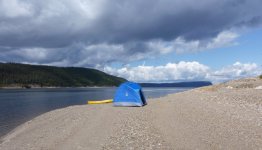
Conditions were once again very nice, some sun, some cloud, the water not quite “like glass” but close with no precipitation in the forecast. The cliffs are a bit of a letdown, while very high they are obscured by trees and do not come down right to the water. Looking east to the mainland there is a little less haze than of previous days; I wonder if the haze is actually smoke from wildfires currently burning in Nova Scotia and Newfoundland.

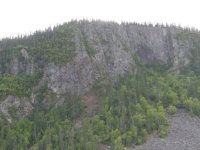
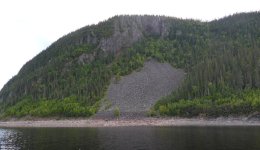
I came on a very shallow area, is some spots shallow would be an understatement, a lot of exposed lakebed showing just how low the water levels are; remember that the levels are controlled by Hydro Quebec.
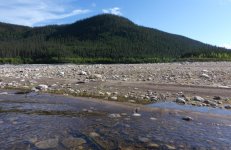

I had made note of a small cove on my map, it was my theoretical destination for the day. With my late start, I would not make it there if I stuck to my general standard plan to stop for the day with at least one hour before sunset. I was passing quit a few reasonable places but decided to keep going, It was definitely sheltered but the banks of the cove were poor, a series of not very wide shelves covered in rocks of various sizes, behind this was a thick band of small trees and bushes. At the deepest point of the cove, there was an area of damp sand with a few tufts of grass. The best qualities of this location, very sheltered, absolutely flat, very close to the water and surprisingly free of bugs. It was cooling down quickly; I set up, put on some extra clothing and settled in. I snacked on some hummus, thought about frying up the last of the chicken but instead just had some cheese sandwiches; I just did not feel very hungry.
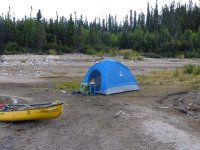
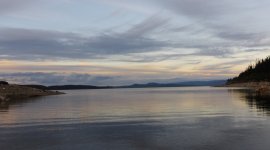
I received a warning notice of inclement weather on the way, I will get an updated forecast in the morning; probably do another 20km if I can get away at a reasonable time (noon perhaps?). I will be on the lookout for any good spots as it is likely I will be holed up there for at least two nights. Just before midnight I was about to tidy up and get off to bed when some light rain began to fall. I had to step out and quickly cover the screen windows.
August 22 - Day 3
Distance: 19.3km (Total 54.3km)
Time: 5hr 33m
Caltopo Map: https://caltopo.com/m/B8MTMST
I was up at 9:00am, another breakfast of peaches and strawberries and last night’s tea from the Thermos along with a few spoonful’s of pie. There is a mix of sun and cloud which is heating up the POD, I opened up the windows all round to make it a bit more comfortable. Rain had woken me up once during the night, I don’t think there was very much in total. I am aiming to be on the water by 12:30, my aim is not very good; I did not get away until about 1:30pm.

Conditions were once again very nice, some sun, some cloud, the water not quite “like glass” but close with no precipitation in the forecast. The cliffs are a bit of a letdown, while very high they are obscured by trees and do not come down right to the water. Looking east to the mainland there is a little less haze than of previous days; I wonder if the haze is actually smoke from wildfires currently burning in Nova Scotia and Newfoundland.



I came on a very shallow area, is some spots shallow would be an understatement, a lot of exposed lakebed showing just how low the water levels are; remember that the levels are controlled by Hydro Quebec.


I had made note of a small cove on my map, it was my theoretical destination for the day. With my late start, I would not make it there if I stuck to my general standard plan to stop for the day with at least one hour before sunset. I was passing quit a few reasonable places but decided to keep going, It was definitely sheltered but the banks of the cove were poor, a series of not very wide shelves covered in rocks of various sizes, behind this was a thick band of small trees and bushes. At the deepest point of the cove, there was an area of damp sand with a few tufts of grass. The best qualities of this location, very sheltered, absolutely flat, very close to the water and surprisingly free of bugs. It was cooling down quickly; I set up, put on some extra clothing and settled in. I snacked on some hummus, thought about frying up the last of the chicken but instead just had some cheese sandwiches; I just did not feel very hungry.


I received a warning notice of inclement weather on the way, I will get an updated forecast in the morning; probably do another 20km if I can get away at a reasonable time (noon perhaps?). I will be on the lookout for any good spots as it is likely I will be holed up there for at least two nights. Just before midnight I was about to tidy up and get off to bed when some light rain began to fall. I had to step out and quickly cover the screen windows.
I dunno, that unrefrigerated chicken was probably just about ready to fly again on its own, propelled by multiple hosts of winged bacteria. How long do you keep one of those things going?
- Joined
- Aug 10, 2018
- Messages
- 2,060
- Reaction score
- 6,872
You're doing better than I ever have. I can't remember getting a TR together earlier than a month after returning.Sorry about the delay....a little craziness going on here!
I was wondering that myself. I've eaten 2 week-old bacon in the woods but I don't trust chicken past about 4-5 days in the fridge at home.I dunno, that unrefrigerated chicken was probably just about ready to fly again on its own, propelled by multiple hosts of winged bacteria. How long do you keep one of those things going?
Maybe leave the chicken on top of the barrel & the bears aren't brave enough to risk it?I wondered what procedures (if any) you employed for bear protection of your food on this trip, or in general on your many long wilderness trips.
You averaged almost 2.7 mph which I think is very good, especially with that hull. You must not have taken many breaks, if any, and I wondered if you had a tailwind.
At that point just slight tailwinds, I take floating breaks on a regular basis, if you zoom in on the Caltopo track you can see the little zigzags where I pause for a smoke or to take pictures, I rarely get out on dry land, that's where the bugs are and then they tag along for the next 5 minutes. There is nothing "fast" about that Mohawk, especially full of gear, I would guess that the total payload is about 300lbs (I'm less than half of that)
According to Alvin Einstein, if you paddle counterclockwise you will travel into the past. I'm pretty sure you did that, but am too chicken to edit your direction.
If you can edit PLEASE do so!
I dunno, that unrefrigerated chicken was probably just about ready to fly again on its own, propelled by multiple hosts of winged bacteria. How long do you keep one of those things going?
Yeah at the end of Day 3 it has been 78 hours since the chicken left to the rotisserie, when dinner comes on Day 4 it will be 96 hours! I admit to having some concerns about this and to be honest I haven't reviewed my notes for Day 4 and don't remember what my decision was (intentional cliff hanger for episode 4).
@recped, looking at the picture of your barrel and pack next to your tent, I wondered what procedures (if any) you employed for bear protection of your food on this trip, or in general on your many long wilderness trips. Maybe you've stated before in threads, but I don't recall.
The barrel and pack are on there way into the POD.
I generally avoid discussions about bears, guns often enter into the back and forth and both topics can be divisive. I will answer your question but I ask that if anyone want to continue the topic please start another thread.
First thing, I am only talking about the black bears of Ontario, Quebec and the eastern part of Manitoba. I have only car camped in the grizzly zones and my 2 trips into polar bear territory required a completely different attitude.
Basically I don't worry about bear issues on most of my trips, I know they are around but the odds of a negative (injury or death) encounter is extremely low overall, the few incidents that have happened are almost all in areas such as active Provincial/Federal Parks, active fly-in lodges and of course any areas infected with cottages. The fly-in lodges and to a lesser extent outpost camps are the riskiest locations for camping, I try to avoid them unless they are unoccupied and I can get inside.
Any bear sightings at all are pretty rare (doesn't mean they are not seeing me), maybe 1 bear every 50+ paddling days with 90% of those consisting of not much more that a flash of bear bum as it's scurries away into the bush as I paddle past, I have VERY few pictures of bears, any the ones I do have are barely identifiable. I do have one good video of a bear that came to visit me on the Natashquan in 2015, maybe I'll finally upload it to You Tube, it shows his lack of interest in coming any closer to me than needed but he was definitely aware that I was there watching him. I also have a few decent stills of a large bear on the George River that was only interested in eating the fish he snagged, payed almost no attention to the three canoes that were drifting along maybe 20 metres away.
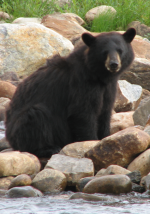
On to my procedures.......
When I am selecting a campsite I do usually have a quick look around for any recent signs of bear activity, usually I'll move on if there are any fresh tracks.
All my gear (including food) is inside the POD with me, I generally ensure that all food item are put away, even though I know that the smells don't go away, any bear withing a couple of kilometres already knows I'm there. Perhaps being a very stinky solo paddler helps keep them away? I would not be surprised if bears visit my camps after I have left but they will find NOTHING. On many of my trips I am camping in locations which likely has never had another camper or perhaps 1 every few years or on more active routes 1 or 2 paddlers/groups per year. In the areas I mostly travel pretty much everyone is responsible, there may be signs of previous users but I only find trash at remote fish camps and sad to say areas near First Nations reserves.
Time of year makes a difference, I have more concern during early Spring trips, where a bear might be a little hungry, If I do have serious concerns I might utilize my 2 person tent in addition to the shelter, sleep in that and leave all my gear in the shelter.
On this Manic trip I know for a fact there are quite a few bears on the big island, my thinking is that I'm paddling during peak blueberry season, there are no berries at all around the shoreline but inland I know there are large areas that were forested in the not too distant past (there is no active cutting there) that would be providing prime blueberry ground along with all the potential food surround all the small lakes and creeks in the interior. I did see quite a few moose tracks along the shore but even those seemed to be solitary animals making only brief forays to the shoreline again, not much moose food along the shoreline.
I do not own firearms, I do carry bear bangers and flares (never used), most of the time they are buried in my gear, occasionally I'll get them out and pre-load them, If a bear came to camp that was in any way aggressive my intent would be to grab the bangers and my InReach. jump in my canoe and observe from a safe distance. I would make no attempt to protect my gear or engage other than perhaps to launch a banger as I leave. Worst case scenario (destruction of my camp) rescue within 24 - 48 hours is almost certain unless weather is so bad that neither heli's or flat planes can fly. Even without an InReach I usually have somebody following me who would notice my silence and raise the alarm if there was no activity for several days.
If you don't have an InReach, how will someone follow you?
Nice photo of the bear.
Nice photo of the bear.
f you don't have an InReach, how will someone follow you?
I think he means that people following online will notice the track has stopped updating.
Alan
I just reread it. That's assuming he has an InReach but left it in camp.
I generally avoid discussions about bears . . . . I will answer your question but I ask that if anyone want to continue the topic please start another thread.
I agree.
Since you are undoubtedly one of the most experienced Canadian wilderness trippers on this site, I was mainly interested in whether you hide your food barrel/pack far away from your tent or hang it in trees. I take it you don't do either, other than sometimes putting it in a separate shelter in the situations you describe.
August 23 - Day 4
Distance: 12.1km (Total 66.4km)
Time: 3hr 45m
Caltopo Map: https://caltopo.com/m/B8MTMST
I was up at 9:30am. It had rained much of the night based on the amount of water that had collected in the canoe, still misty rain now. The forecast calls for real rain to start in the early evening and continue through to Sunday evening. If I move on today I will need to find a good sheltered location to hang out until at least Monday, wind from the south will be increasing during that period. The map suggests some possible sheltered spots about 15km away.

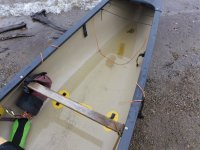
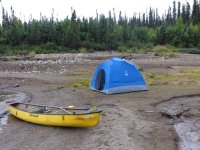
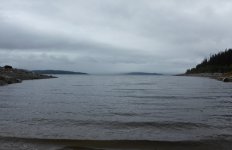

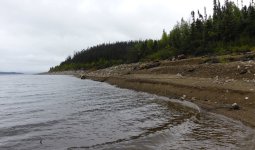
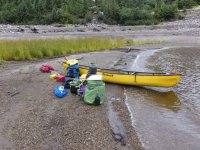
Breakfast was another big bowl of peaches and strawberries, I have maybe one more serving before “fruit rot” sets in, actually doing well to still have an edible supply 6 days since leaving home. I was packed and ready to go at 1:10pm, 100% cloud cover with a very low ceiling, many of the “peaks” are hidden behind the clouds that are only a couple of hundred feet above the water. Light wind and waves are coming from the west, this does not match the forecast but of course, the forecasts are based on wind speed/direction well above the surface while the hilly terrain can create wind directions that never line up with those forecasts. I was making reasonable progress until about 4:00pm when light rain started a little earlier than I had anticipated. I decided to abandon my target that was still 1 – 2 hours away and instead take the first sheltered spot I came across.
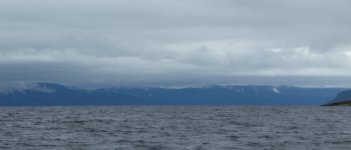
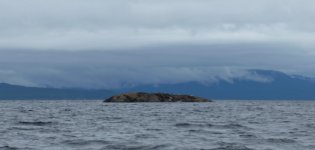
I came upon a very wide beach section, behind the beach there was an area of moss with some small trees that would help provide a windbreak and closer to the hills that should provide some protection if the winds are actually from the south. It is a long way to lug my gear but staying out in the open is probably not a wise choice. In a pinch I could set up my 2 person Marmot Sanctum tent, it is very secure in high winds but I really don’t like having to hang out in such a relatively confined space.
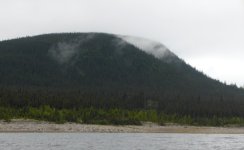
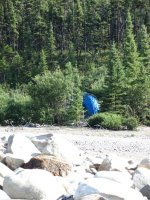
Once I had set up the POD I made tea and ate some pie, it was too early for dinner so I updated my notes and enjoyed a couple of bowls. Eventually it was time to decide on dinner. It was now 4 days since I picked up the chicken in Quebec City, it looked fine, smelled ok so I was not too worried. I would give it a little extra time in the fry pan and depend on my “steel stomach”, I’ve eaten a lot worse looking food in the past, after eating a couple of chicken wraps I waited for a half hour with no ill effects.
Light rain started around 7:30pm, the combination of active rain, already wet ground and just two small vents leads to a lot of condensation inside the POD. I would need to be a little careful to keep my gear dry; the important step is to put my sleeping bag inside my Gore-Tex bivy sack, not a good plan to let a down bag get wet during an extended period of rain. Just before 10:00pm, the rain paused but replaced with lots of thunder and lightning. I expected heavy rain to begin at any time.
While all this is going on, I was having fun watching a frog slowly move around inside the POD, at first it was an obvious adult frog, just a small one. A few minutes later, an obvious child frog started leaping about inside the POD, it was shortly joined by another baby frog. Now they are all hopping around checking out this strange place they have found themselves in. Mommy frog now starts to try to find a way to exit, the kids are now trying to climb the walls of the shelter, quite funny to watch as they leap up about 6+ inches, attempt to grasp on to the tent fabric then instantly losing contact sliding back to the ground. After a bit more of this entertainment I take pity on them, grab them one at a time, lift the flaps and toss them outside. Eventually I have them all out so I sit back and relax. It’s only a couple of minutes when one of the babies has snuck back it, a few more minutes and all three are back inside, one of the babies is intent on being my new friend, first it makes several attempts to climb up to my lap, several failures and it seems satisfied to sit on my boot. After some more of this entertainment I toss them all out again, by this point it is raining quite hard and that is the last I saw of them. It is now Midnight and I am off to bed, I do not know if they ever came back for another visit.
Distance: 12.1km (Total 66.4km)
Time: 3hr 45m
Caltopo Map: https://caltopo.com/m/B8MTMST
I was up at 9:30am. It had rained much of the night based on the amount of water that had collected in the canoe, still misty rain now. The forecast calls for real rain to start in the early evening and continue through to Sunday evening. If I move on today I will need to find a good sheltered location to hang out until at least Monday, wind from the south will be increasing during that period. The map suggests some possible sheltered spots about 15km away.







Breakfast was another big bowl of peaches and strawberries, I have maybe one more serving before “fruit rot” sets in, actually doing well to still have an edible supply 6 days since leaving home. I was packed and ready to go at 1:10pm, 100% cloud cover with a very low ceiling, many of the “peaks” are hidden behind the clouds that are only a couple of hundred feet above the water. Light wind and waves are coming from the west, this does not match the forecast but of course, the forecasts are based on wind speed/direction well above the surface while the hilly terrain can create wind directions that never line up with those forecasts. I was making reasonable progress until about 4:00pm when light rain started a little earlier than I had anticipated. I decided to abandon my target that was still 1 – 2 hours away and instead take the first sheltered spot I came across.


I came upon a very wide beach section, behind the beach there was an area of moss with some small trees that would help provide a windbreak and closer to the hills that should provide some protection if the winds are actually from the south. It is a long way to lug my gear but staying out in the open is probably not a wise choice. In a pinch I could set up my 2 person Marmot Sanctum tent, it is very secure in high winds but I really don’t like having to hang out in such a relatively confined space.


Once I had set up the POD I made tea and ate some pie, it was too early for dinner so I updated my notes and enjoyed a couple of bowls. Eventually it was time to decide on dinner. It was now 4 days since I picked up the chicken in Quebec City, it looked fine, smelled ok so I was not too worried. I would give it a little extra time in the fry pan and depend on my “steel stomach”, I’ve eaten a lot worse looking food in the past, after eating a couple of chicken wraps I waited for a half hour with no ill effects.
Light rain started around 7:30pm, the combination of active rain, already wet ground and just two small vents leads to a lot of condensation inside the POD. I would need to be a little careful to keep my gear dry; the important step is to put my sleeping bag inside my Gore-Tex bivy sack, not a good plan to let a down bag get wet during an extended period of rain. Just before 10:00pm, the rain paused but replaced with lots of thunder and lightning. I expected heavy rain to begin at any time.
While all this is going on, I was having fun watching a frog slowly move around inside the POD, at first it was an obvious adult frog, just a small one. A few minutes later, an obvious child frog started leaping about inside the POD, it was shortly joined by another baby frog. Now they are all hopping around checking out this strange place they have found themselves in. Mommy frog now starts to try to find a way to exit, the kids are now trying to climb the walls of the shelter, quite funny to watch as they leap up about 6+ inches, attempt to grasp on to the tent fabric then instantly losing contact sliding back to the ground. After a bit more of this entertainment I take pity on them, grab them one at a time, lift the flaps and toss them outside. Eventually I have them all out so I sit back and relax. It’s only a couple of minutes when one of the babies has snuck back it, a few more minutes and all three are back inside, one of the babies is intent on being my new friend, first it makes several attempts to climb up to my lap, several failures and it seems satisfied to sit on my boot. After some more of this entertainment I toss them all out again, by this point it is raining quite hard and that is the last I saw of them. It is now Midnight and I am off to bed, I do not know if they ever came back for another visit.
Last edited:
August 24 - Day 5
Distance: 0km (Total 66.4km)
Time: 0hr 0m
Caltopo Map: https://caltopo.com/m/B8MTMST
I woke up at 10:00am, not raining, no idea when it stopped. 100% cloud cover, wind picking up somewhat but not serious yet. Drank some tea, had a few smokes. Since I had essentially assumed I would be spending the day here it would have taken absolute perfect condition to motivate me to move on. I figured this is a good time to get out my power banks and charge my headlamp, overhead lantern, music player, InReach and camera. My old GPS and a little speaker I rarely use are the only two remaining devices that use regular batteries. (FYI – On this trip I used 2 x 10,000Mah power banks, 8 year old ones that are not top quality, also a small amount of power from my 20,000Mah Anker bank. Also three pairs of Lithium AA’s for the GPS.
Raindrops started to hit my shelter so I figured it would be a good time declare an official layover and return to the comfort of my Mondo pad and sleeping bag. When I woke again at 4:00pm the sun is shining, I went out for a short walk down to the water. Compared to the POD location there was definitely more wind effect on the water. While it was only generating modest waves, it would be a direct headwind; on this kind of trip, I see no reason whatsoever to paddle under these conditions and happy with my decision.
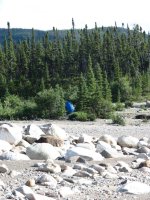
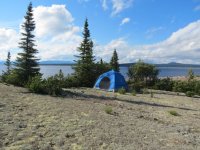
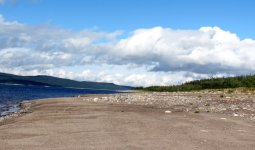
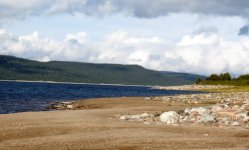
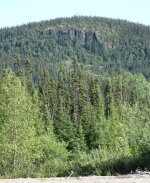
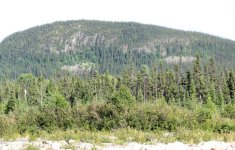
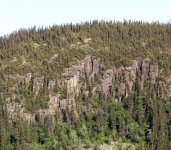
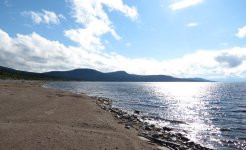
I can hear thunder far to the west, hard to tell if it is coming my way or how significant of a storm might arrive. In any event, it is time to eat, I started with my last peach and whatever strawberries had not gone furry. Made tea, filled the pipe several times, and munched on nuts, jerky, chocolate, a bit of cheese. The storm clouds arrived but passed by with only a few light sprinkles on my camp.

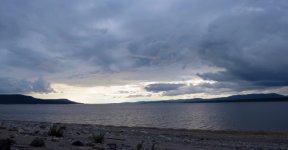
As sunset approached, it was time for an actual dinner. Since I had zero reaction to last night’s chicken I figured I can get one last meal from the remaining scraps, turned out to be quite a bit left on the carcass. I gave it extra time in the pan and added a big chunk of butter to add a few more calories. I am not sure how I will dispose of the carcass, burning it would probably be best but I’m not inclined to have a fire. Bury it? I do not see the point, unless it was very deep some critter would probably dig it up. Toss it in the lake, not generally a popular solution although there are plenty of dead creatures in the lake. Perhaps just leave it on the beach and let the gulls (plenty of them) take care of them (do gulls eat chicken?). I’ll think of something.

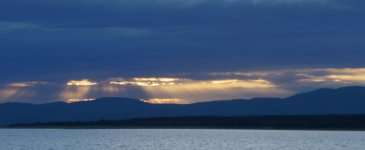

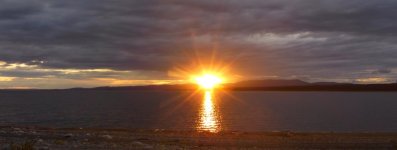
It’s still windy though mostly clear skies, my support informs me that it is going to be wet for a few days coming up, not sure of the accuracy of the source, My InReach forecast tends to be somewhat more accurate, I will g et an update of that before bed or in the morning. I got out the apple pie, still quite a bit left, not sure why that is although it’s somewhat common for me to semi-starve myself for the first few days and then go on an eating binge after that. While this is day 5 I really haven’t been expending much effort so far. I reviewed my maps, I see a good looking area about 20km away, it would be nice if I could find another moss area, I have also considered crossing over to the outer shoreline, there are a couple of cabins over on that side.
Off to bed at midnight!
Distance: 0km (Total 66.4km)
Time: 0hr 0m
Caltopo Map: https://caltopo.com/m/B8MTMST
I woke up at 10:00am, not raining, no idea when it stopped. 100% cloud cover, wind picking up somewhat but not serious yet. Drank some tea, had a few smokes. Since I had essentially assumed I would be spending the day here it would have taken absolute perfect condition to motivate me to move on. I figured this is a good time to get out my power banks and charge my headlamp, overhead lantern, music player, InReach and camera. My old GPS and a little speaker I rarely use are the only two remaining devices that use regular batteries. (FYI – On this trip I used 2 x 10,000Mah power banks, 8 year old ones that are not top quality, also a small amount of power from my 20,000Mah Anker bank. Also three pairs of Lithium AA’s for the GPS.
Raindrops started to hit my shelter so I figured it would be a good time declare an official layover and return to the comfort of my Mondo pad and sleeping bag. When I woke again at 4:00pm the sun is shining, I went out for a short walk down to the water. Compared to the POD location there was definitely more wind effect on the water. While it was only generating modest waves, it would be a direct headwind; on this kind of trip, I see no reason whatsoever to paddle under these conditions and happy with my decision.








I can hear thunder far to the west, hard to tell if it is coming my way or how significant of a storm might arrive. In any event, it is time to eat, I started with my last peach and whatever strawberries had not gone furry. Made tea, filled the pipe several times, and munched on nuts, jerky, chocolate, a bit of cheese. The storm clouds arrived but passed by with only a few light sprinkles on my camp.


As sunset approached, it was time for an actual dinner. Since I had zero reaction to last night’s chicken I figured I can get one last meal from the remaining scraps, turned out to be quite a bit left on the carcass. I gave it extra time in the pan and added a big chunk of butter to add a few more calories. I am not sure how I will dispose of the carcass, burning it would probably be best but I’m not inclined to have a fire. Bury it? I do not see the point, unless it was very deep some critter would probably dig it up. Toss it in the lake, not generally a popular solution although there are plenty of dead creatures in the lake. Perhaps just leave it on the beach and let the gulls (plenty of them) take care of them (do gulls eat chicken?). I’ll think of something.




It’s still windy though mostly clear skies, my support informs me that it is going to be wet for a few days coming up, not sure of the accuracy of the source, My InReach forecast tends to be somewhat more accurate, I will g et an update of that before bed or in the morning. I got out the apple pie, still quite a bit left, not sure why that is although it’s somewhat common for me to semi-starve myself for the first few days and then go on an eating binge after that. While this is day 5 I really haven’t been expending much effort so far. I reviewed my maps, I see a good looking area about 20km away, it would be nice if I could find another moss area, I have also considered crossing over to the outer shoreline, there are a couple of cabins over on that side.
Off to bed at midnight!
You could have boiled the bird carcass down and made a nice chicken soup stock to go with the tiny ziploc bag of pasta I'm sure was floating around in your supplies...August 24 - Day 5
Distance: 0km (Total 66.4km)
Time: 0hr 0m
Caltopo Map: https://caltopo.com/m/B8MTMST
I woke up at 10:00am, not raining, no idea when it stopped. 100% cloud cover, wind picking up somewhat but not serious yet. Drank some tea, had a few smokes. Since I had essentially assumed I would be spending the day here it would have taken absolute perfect condition to motivate me to move on. I figured this is a good time to get out my power banks and charge my headlamp, overhead lantern, music player, InReach and camera. My old GPS and a little speaker I rarely use are the only two remaining devices that use regular batteries. (FYI – On this trip I used 2 x 10,000Mah power banks, 8 year old ones that are not top quality, also a small amount of power from my 20,000Mah Anker bank. Also three pairs of Lithium AA’s for the GPS.
Raindrops started to hit my shelter so I figured it would be a good time declare an official layover and return to the comfort of my Mondo pad and sleeping bag. When I woke again at 4:00pm the sun is shining, I went out for a short walk down to the water. Compared to the POD location there was definitely more wind effect on the water. While it was only generating modest waves, it would be a direct headwind; on this kind of trip, I see no reason whatsoever to paddle under these conditions and happy with my decision.
View attachment 149326
View attachment 149327
View attachment 149328
View attachment 149329
View attachment 149330
View attachment 149331
View attachment 149332
View attachment 149333
I can hear thunder far to the west, hard to tell if it is coming my way or how significant of a storm might arrive. In any event, it is time to eat, I started with my last peach and whatever strawberries had not gone furry. Made tea, filled the pipe several times, and munched on nuts, jerky, chocolate, a bit of cheese. The storm clouds arrived but passed by with only a few light sprinkles on my camp.
View attachment 149334
View attachment 149335
As sunset approached, it was time for an actual dinner. Since I had zero reaction to last night’s chicken I figured I can get one last meal from the remaining scraps, turned out to be quite a bit left on the carcass. I gave it extra time in the pan and added a big chunk of butter to add a few more calories. I am not sure how I will dispose of the carcass, burning it would probably be best but I’m not inclined to have a fire. Bury it? I do not see the point, unless it was very deep some critter would probably dig it up. Toss it in the lake, not generally a popular solution although there are plenty of dead creatures in the lake. Perhaps just leave it on the beach and let the gulls (plenty of them) take care of them (do gulls eat chicken?). I’ll think of something.
View attachment 149336
View attachment 149337
View attachment 149338
View attachment 149339
It’s still windy though mostly clear skies, my support informs me that it is going to be wet for a few days coming up, not sure of the accuracy of the source, My InReach forecast tends to be somewhat more accurate, I will g et an update of that before bed or in the morning. I got out the apple pie, still quite a bit left, not sure why that is although it’s somewhat common for me to semi-starve myself for the first few days and then go on an eating binge after that. While this is day 5 I really haven’t been expending much effort so far. I reviewed my maps, I see a good looking area about 20km away, it would be nice if I could find another moss area, I have also considered crossing over to the outer shoreline, there are a couple of cabins over on that side.
Off to bed at midnight!
You could have boiled the bird carcass down and made a nice chicken soup stock to go with the tiny ziploc bag of pasta I'm sure was floating around in your supplies...
Ah you know me too well! The stock pot is where virtually every Costco carcass ends up. I did consider this option and was encouraged by Fuddle to do so. I explained to Fuddle that while I had some rice and peppercorns I did not have a carrot, no celery, no onion or bay leaves. All are critical ingredients for a good soup stock.
Fuddle
Is Fuddle also called Douglas? Just trying to keep the cast of (Malaysians?) straight from your George River report.
Is Fuddle also called Douglas? Just trying to keep the cast of (Malaysians?) straight from your George River report.
Douglas "retired" from paddling. A few years ago during a shuttle ride he was savagely attacked by a pit bull, he has never left the house since that traumatic event.
I gave a thumbs up for the mirepoix reference, or whatever holy trinity you cook with. (https://www.seriouseats.com/all-about-mirepoix)
A chicken stock would've been inspired camp cooking, but maybe next trip.
No idea what the vid was about. lol
A chicken stock would've been inspired camp cooking, but maybe next trip.
No idea what the vid was about. lol
You had said that your load was 300lbs and that you were less than half that. I understand now. On day 5 I would have been on chicken number 3.
I am a "small guy" in both height and girth, always have been, for the last 20+ years I have been shrinking in all directions. It became more pronounced in the last few years. I have been taunted by some with comments like "he eats like a bird".
On this relatively short and easy going trip I lost 5.5% of my body weight, maybe I'll get it back by Christmas.
On my long trips caloric deficiency usually sets in after week two, by week four I'll be digging in to the snack pack at any opportunity.
That's said if I go on a trip with @VA paddler I can come home and find I've actually gained a few pounds!
On this relatively short and easy going trip I lost 5.5% of my body weight, maybe I'll get it back by Christmas.
On my long trips caloric deficiency usually sets in after week two, by week four I'll be digging in to the snack pack at any opportunity.
That's said if I go on a trip with @VA paddler I can come home and find I've actually gained a few pounds!
Similar threads
- Replies
- 30
- Views
- 4K
- Replies
- 12
- Views
- 2K
- Replies
- 6
- Views
- 1K
